2021 – Battery options modelling
In September 2020 we installed our first battery at Sturt Apartments, Christie Walk. You can read the story of our modelling, battery choices and lessons learned in Episode 7 – Battery storage – Tesla PowerWall 2
Everything had gone to plan with the installation of the battery; performance was as expected. The savings generated by our PV upgrade and the battery were flowing into our Green Fund, enabling us to begin planning for the installation of our second battery.
Our modelling indicated that our 21kW PVs were generating enough power to usefully support up to about 55kWh of battery storage, corresponding to 4 x Tesla PowerWall 2 batteries. In cost-benefit terms, a sweet-spot would be with 2 batteries. In the depths of winter in July – on many days – we’d still generate enough spare power to fully charge the batteries for use after sundown.
The estimates went like this, for a building of 13 apartments usually housing 21 people:
- With 1 x 13.5kWh battery we’d store enough from our PVs to power us through the early-evening peak usage on most days all year round.
- With 2 batteries we’d also cover more of the evening usage, and at times, some of the early morning peak, mainly in the warmer 6 months of the year.
- With 3 batteries we’d be fully self-powered for 6 months of the year.
- With 4 batteries we’d be fully self-powered all year round, and would still be exporting some spare power to the grid every month.
Goals
1) Further cut our emissions by reducing our imports of energy from the grid, self-consuming more of our green PV power instead.
2) Assist in the efforts of AEMO and SAPN in ensuring security and stability of the grid which is becoming dominated by renewables:
– Store more PV energy in the middle of the day to avoid contributing to overloading the local grid with solar generation.
– Import less energy from the grid at times of peak demand such as in the early evening and early morning.
FAQ
Here are some Frequently Asked Questions that we worked through during the planning process:
Q: Do we produce enough excess power?
A: Yes. Even in winter, the PVs produce 27kWh excess power per day on average. Maximum useable battery capacity is 13.5kWh per battery, so we produce enough power to utilise two batteries.
Q: Will Sturt Apartments still need to import power from the grid?
A: Yes. To make Sturt Apartments fully self-sufficient for power we would need to add more PVs and additional batteries.
Q: What is the financial benefit of adding a second battery?
A: The $9k annual income into the Green Fund that we currently produce is heavily dependent on the good 16.5c feed-in tariff that we receive. But we cannot expect that to remain as high as 16.5c. Wholesale prices for power in SA are extremely low in the middle of the day when rooftop PVs are feeding into the grid, sometimes going negative. We can expect several changes:
1) Significantly reduced feed-in tariffs overall. It’s already started to happen elsewhere (e.g. in 2020 NT dropped feed-in tariff from about 35c to 8.3c).
2) Variable feed-in tariffs, adjusted by time-of-day.
3) Export curtailment during periods of high rooftop solar export.
4) Solar export fees.
Adding a second battery will make us less dependent on unpredictable feed-in tariff income.
Q: Why not wait for the next edition of the Tesla PowerWall?
A: Two changes are expected in future editions of the Tesla PowerWall:
1) PowerWall+ – storage capacity remains at 13.5kWh, but output rate increases from 5kW to 9.6kW. Will be more expensive, and we don’t need the increased output rate.
2) Tesla’s new higher-efficiency 4680 “tabless” battery design will enable more energy to be stored in the available space. This is likely to be introduced in Tesla cars first and PowerWalls later. It could be several years before this new technology is available in PowerWalls sold in Australia.
Q: How much will the Green Fund benefit?
A: The annual benefit depends on the ratio of the retail cost of electricity vs the feed-in tariff, so that’s impossible to predict into the future. But no matter what, the benefit will continue to increase.
Currently the ratio is 35.8c/16.5c = 2.2. So each kWh we use onsite – instead of exporting – doubles in value.
If in the future the average feed-in tariff drops to 8c, the ratio becomes 35.8/8 = 4.5, so that would make the battery even more beneficial financially. For the 2022 calendar year – with the second battery installed in 2021 – we can reasonably expect the annual Green Fund income to increase from $9k to $10k and more.
Strata Approval
For investments of this size, Strata rules require unanimous approval of all members – in person or by proxy – so we set up an extraordinary meeting to obtain consent. Having done that, we ordered the battery in May and it was supplied, installed and commissioned by DQ Electrical in a single day on 24th June 2021.
Installation considerations
Because the Tesla PowerWall 2 is slim (only 146mm) it’s convenient to mount the second battery in front of the first. Tesla supply a special bracket for this purpose. This was ideal for us; the two batteries are in place without reducing the number of bikes stored in our bike shed.
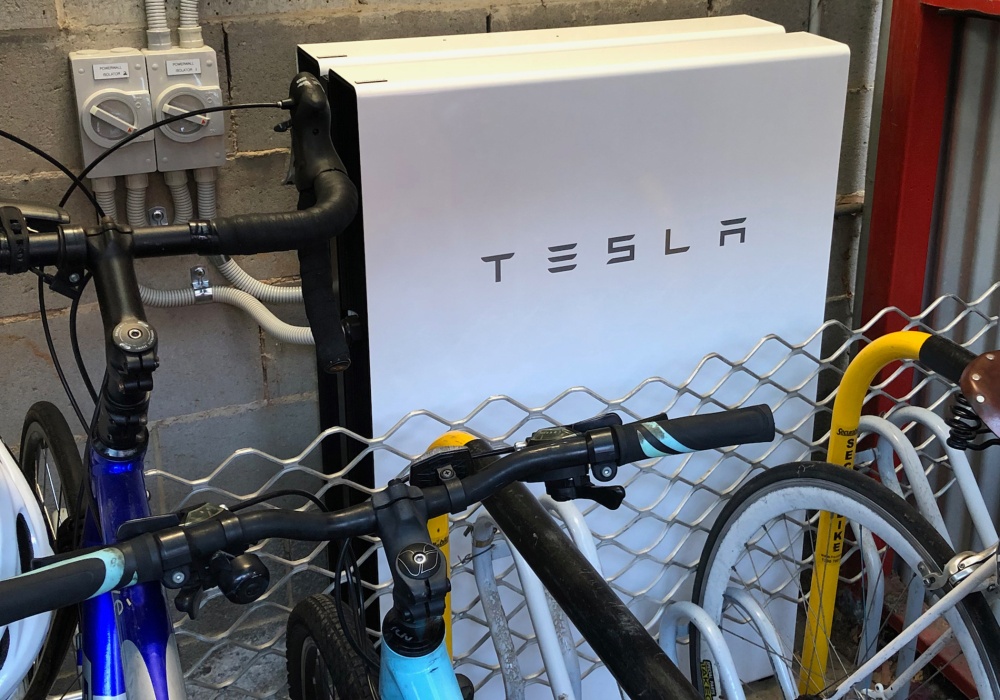
An additional run of wiring back to our existing Tesla GateWay 2 was required which is what took most of the time on installation day.
At present the Tesla App treats the two batteries as if they are one battery of double the size. This is fine for accumulation and export of performance data. But it means you can’t administer and monitor the batteries individually; whatever settings you apply are set to both batteries.
In our case, since we are an inner-city location, power failures are rare, so we only reserve 5% of battery capacity for backup of a small selection of essential circuits.
So the maximum theoretical daily storage we have is:
2 batteries x 13.5kWh each x 90% round trip efficiency x 95% allowing for 5% reserved = 23kWh.
Relief
Post-installation there have been two huge sighs of relief as we monitor performance.
– Power throughput – both into the battery and out to the building – has doubled from 5kW to 10kW. There was some uncertainty about this during installation. The electrician felt that the Gateway would effectively make the two batteries take turns during charge and discharge cycles. If that had been correct we would still have been limited to 5kW in and out. So it was a huge relief the first time the Tesla App showed the planned 10kW being delivered into the batteries.
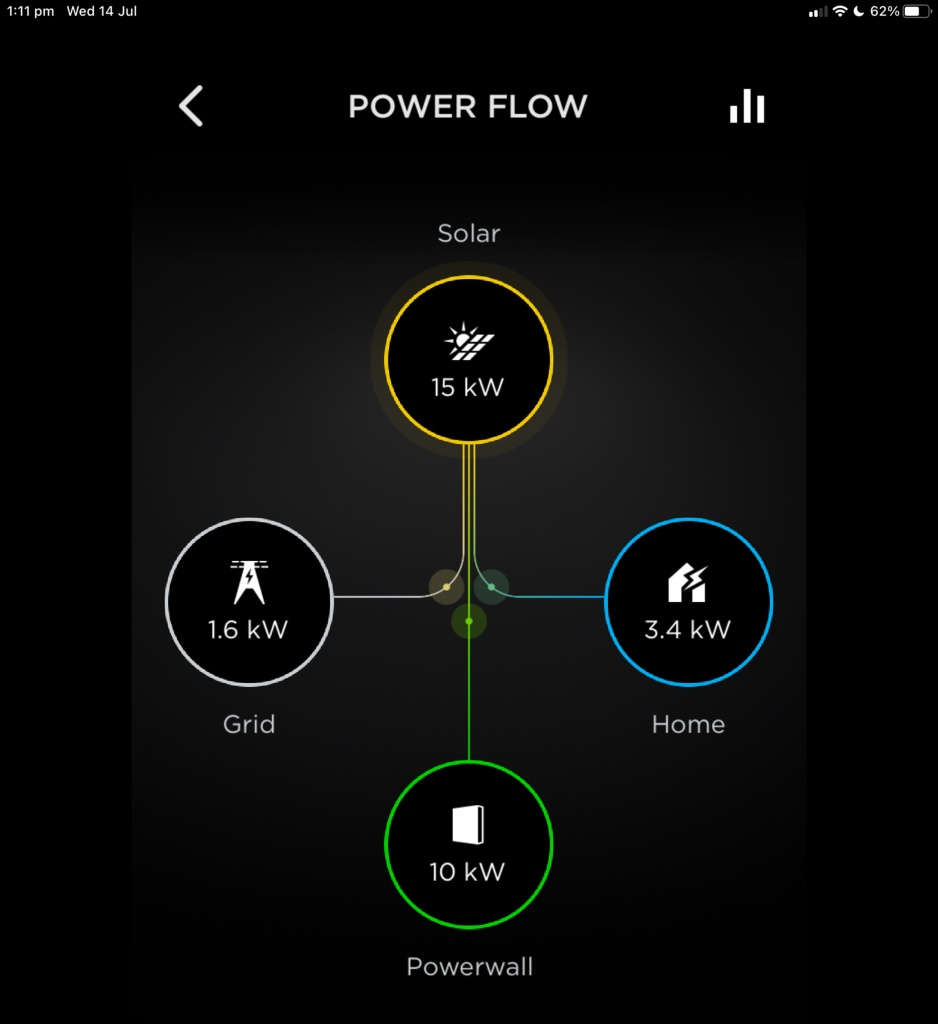
This is particularly important in winter when days are typically a mix of overcast and sunshine.
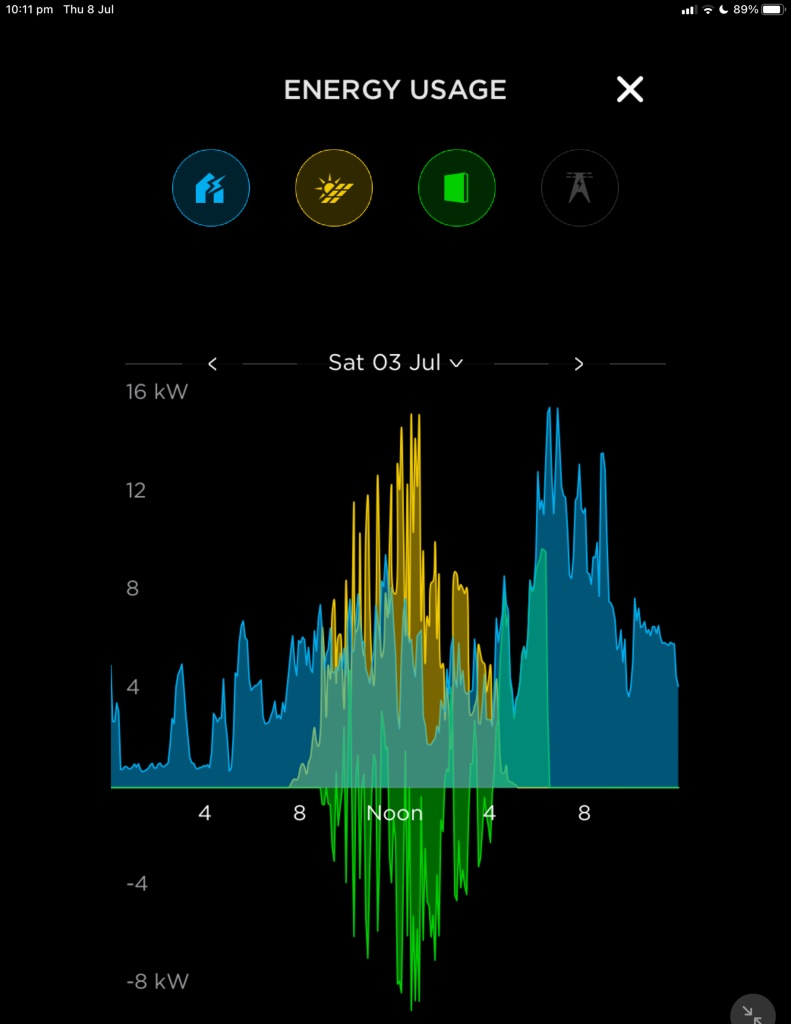
Similarly 10kW continuous output at night is great for coping with most of the peak demand periods in the building. Thanks to our residents’ alertness to energy use, and the excellent passive performance of our well-insulated electric-only building, it’s rare for demand from our 13 apartments to exceed an average of 1kW each. That’s remarkably low. So the peaks above 10kW total building demand are short-lived.
– Energy output per day has also doubled, as expected. Compared with the theoretical 23kWh calculated above, even in the depths of winter we’ve seen some days higher than that. Excellent!
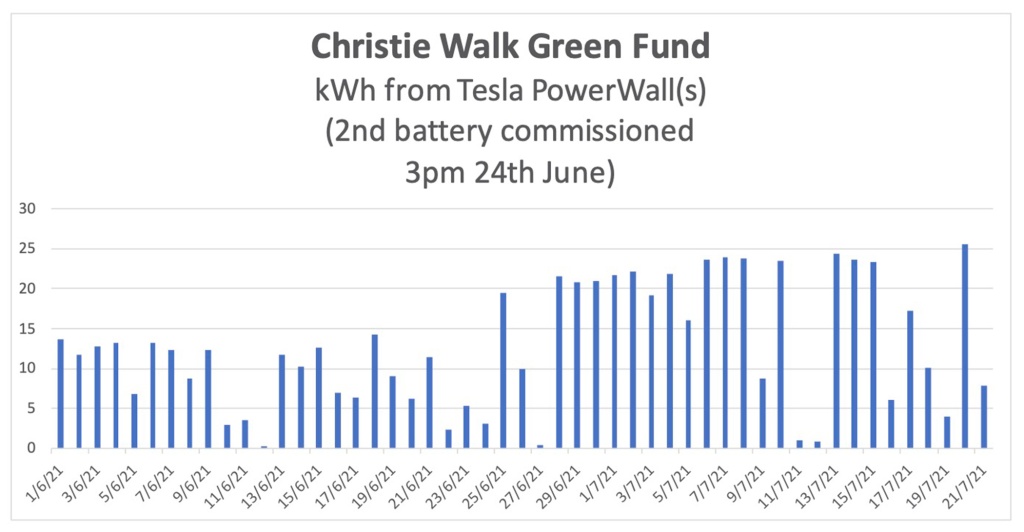
Cost
Total cost of the battery was $14k, including supply, installation, cabling and commissioning.
As this was our second battery, we were not eligible for any rebates or grants.
So how are we going?
This installation is part of our ongoing efforts towards sustainability. Here’s a very satisfying picture of how it’s going.

Now with 2 batteries we’re also using less grid power by improving self-consumption. For 2022 – when we’ve had both batteries for the full calendar year – the proportion of self-consumption will be even greater.
Progress for Christie Walk overall
Total annual emissions for the 27 households at Christie Walk were measured at 50tCO2-e in 2017. In the 5 years since then we’ve reduced emissions by 64% to 18.2tCO2-e, a wonderful outcome. Here’s how:
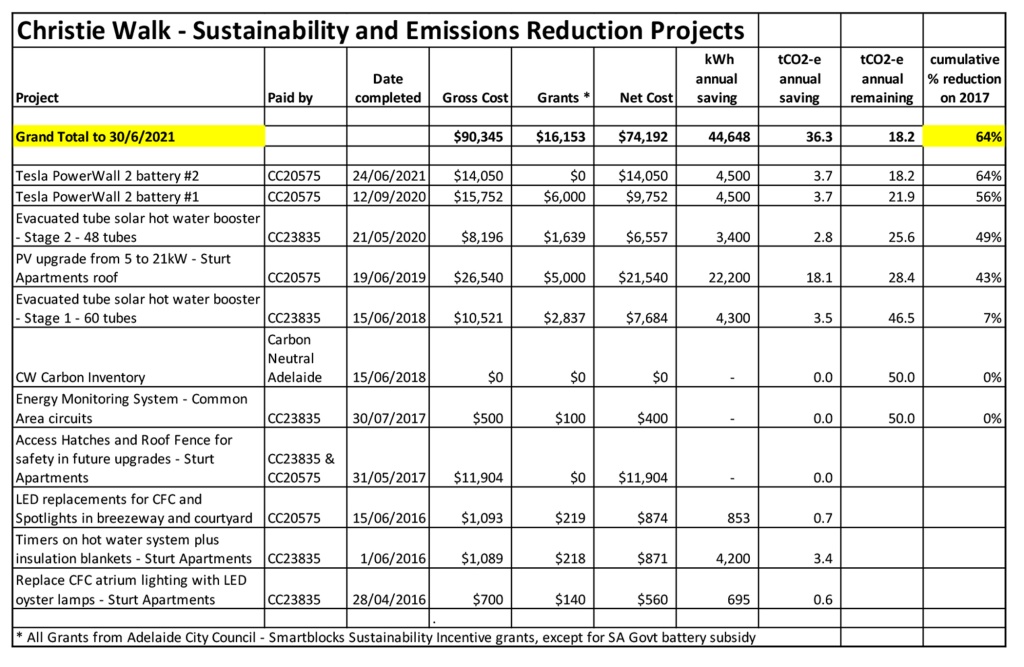
You can continue reading of our adventure with Episode 10 – Time-shifting energy usage.
It’s part of our special series:
Aiming beyond NetZero at Christie Walk – Adventures with an environmentally conscious inner-urban community.


Leave a Reply